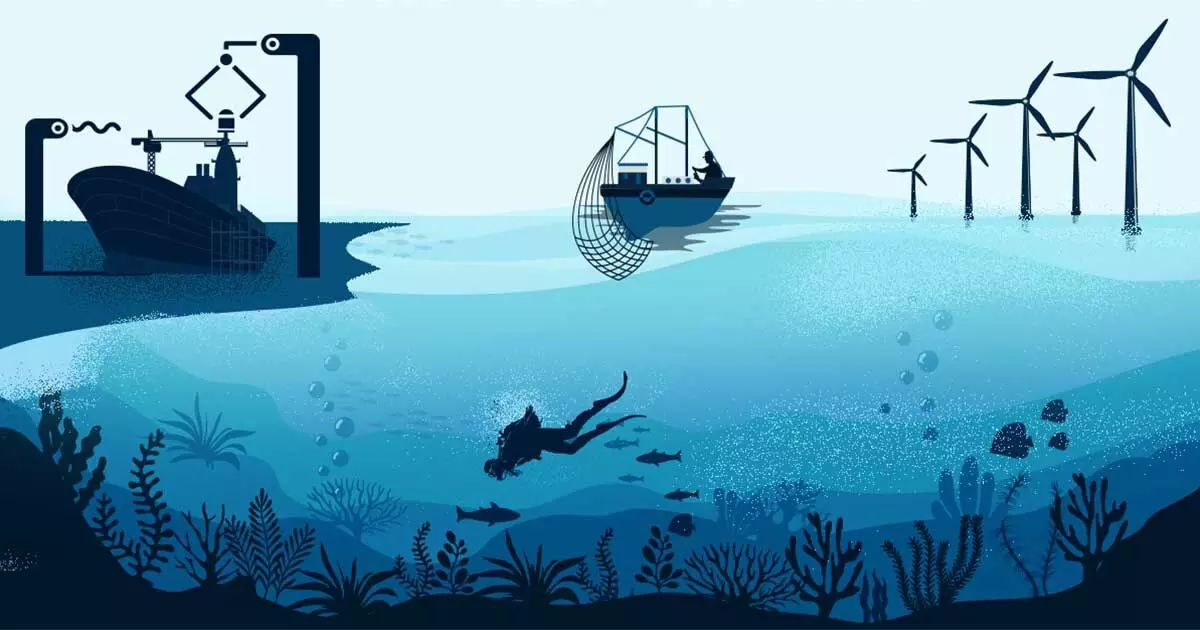Blue Promises, Grey Realities
As the world pivots from ‘green’ to ‘blue’ growth, India faces a paradox — harnessing its vast ocean wealth without triggering a modern-day ‘Halahal’

Since the early 1990s, a debate on the cause of global warming has presented the concept of ‘sustainable development’ and ‘green economy’. Burning of fossil fuels like coal, petroleum, and natural gas has been primarily responsible for warming the global temperature during the post-industrial revolution phase of economic growth. This narrative of sustainable economic development for a ‘green economy’ dominated the political agenda of the major developed countries, led by Europe.
From Green to Blue Economy
Surprisingly, despite spending billions, the global economy still runs on ‘dirty fossil fuel’ and to date, global politics revolves around oil and gas. The recent conflict between India and China, with the USA on the purchase of Russian crude, is a case in point. The ‘green economy’ has failed to meet the expectations of its promoters.
The energy-hungry world burnt 1.5 per cent more fossil fuel in 2023 compared to the previous year. Fossil fuels comprised around 82 per cent of the global energy mix in 2023. In 1990, the share of fossil fuel in the energy mix was nearly the same- around 80-82 per cent. The colossal failure of the promoters of the ‘green economy’ got an official assertion when the International Union for Conservation of Nature (IUCN), on October 16, adopted Motion 042, making it the first multilateral body to explicitly name fossil fuel production as a threat to nature. IUCN called for governments and civil society to confront the root causes of the intertwined climate and biodiversity crises through supply-side measures. It also encouraged exploration of new international instruments, including a potential Fossil Fuel Non-Proliferation Treaty, to address what the IUCN calls a “critical gap in global governance” on fossil fuel supply.
Recent studies indicate that the blue economy, which places economic growth from oceans at the centre, within contemporary environmental governance, has become an influential concept in international and national marine governance discourse. It refers to a broad set of policies aiming to support ocean-based economic activities that provide simultaneous improvements for economic, social, and environmental outcomes. Within this narrative, oceans are undergoing a reconfiguration as economic frontiers and have been heralded as a new approach to ocean governance.
October 26, 2018, marked the beginning of PROBLUE- a World Bank initiative to deliver analytical work, provide technical assistance, and support blue economy projects around the globe. A few other major initiatives, like the Sustainable Ocean Business Action Platform and Sustainable Blue Economy Finance Initiative, were taken for the promotion of the Blue Economy.
In September, 2025, another major milestone has been reached, towards the development of the global Blue economy, in the last month, when Morocco ratified the High Seas Treaty under the UN Convention on the Law of the Sea. It is a landmark event in the efforts to protect the genetic diversity and ecology of vast zones of oceans and seas outside the territorial waters of nations. The treaty was finalised by UN members in 2023, and it will provide the legal framework for the sustainable use and conservation of marine resources. Though the seas constitute two-thirds of the world’s oceans, less than 10 per cent of them are legally protected now. It is set to become international law in January 2026.
Major players of the Blue economy
During the first two decades of this millennium, the volume of goods transported by container shipping each year has quadrupled, and almost one million kilometres of submarine cables have been laid on the seafloor in that time, which carry almost all international telecommunications. The energy generated by offshore wind farms has increased 400-fold in the first two decades, and the volume of farmed seafood has grown by 5 per cent on average each year. During the same time period, most major discoveries of oil and gas deposits have been made offshore, and around 1.4 million square kilometres of the seabed have been leased for exploratory mining. There was practically no marine biotechnology sector at the turn of the millennium, but since then, more than 13,000 marine genetic sequences have been patented in two decades. “The blue acceleration”, i.e. rapid expansion of ocean-based industries since 2000, risks transforming marine ecosystems, and consuming the shared spaces of one of the world’s largest and oldest employers – small-scale fisheries.
Five years ago (2020), the 10 largest companies in eight core ocean economy industries generated, on average, 45 per cent of each industry’s total revenues. Aggregating across all eight industries, the 100 largest corporations (the “Ocean 100”) accounted for 60 per cent of total revenues. The biggest industry in the Ocean 100 was offshore oil and gas, who’s TNCs accounted for approximately 65 per cent of the total revenues, followed by shipping (12 per cent), shipbuilding and repair (8 per cent), maritime equipment and construction (5 per cent), seafood production (4 per cent), cruise tourism (3 per cent), and port activities (2 per cent). Only one TNC in the offshore wind industry was big enough to be included in the Ocean 100 list, generating <1 per cent of the total revenues of this group. The biggest company in the ocean economy by annual revenues was the oil and gas company Saudi Aramco, and 9 of the 10 largest companies in the ocean economy were in the offshore oil and gas industry. Excluding offshore oil and gas, the biggest company was A.P. Moller-Maersk, and 5 of the 10 largest companies were container shipping TNCs. Overall, the biggest non-oil and gas industry was container shipping (30 per cent), followed by shipbuilding and repair (23 per cent), maritime equipment and construction (16 per cent), seafood production (13 per cent), cruise tourism and port activities (8 per cent each), and offshore wind (2 per cent).
According to Capital Monitor, as of May 2021, only three firms, Black Rock, State Street Global Advisors (SSGA) and Vanguard, collectively owned the biggest proportion of shares in the Ocean 100. It amounted to 30 per cent of the ocean economy when shares in each company are adjusted to the company’s proportion of revenue in the ocean.
Indian Blue Economy
India’s blue economy, anchored on sustainable ocean resource utilisation, contributes around 4 per cent to national GDP and facilitates 95 per cent of trade by volume through maritime routes. High growth sectors such as fisheries, shipping, renewable energy and tourism offer significant potential for economic diversification and job creation. The Maritime Amrit Kaal Vision 2047, launched in 2023 during the Global Maritime India Summit (GMIS), is a long-term roadmap for India’s maritime sector, aiming to transform it into a global superpower by 2047. The nine coastal states of India have a total coastline of around 5423 km. In addition to this, India has many islands which contribute to India’s huge exclusive economic zone (EEZ). Beyond this EEZ (200 miles from the shore), India also has mining rights on its continental shelf (up to 350 miles from the shore). Thus, the area of India’s Continental shelf, on which it has sovereign mining rights, is larger than India’s land mass.
The major players, particularly from the developed countries, pursuing industrial and commercial fishing have been looting the oceans with large capacity equipment and over-fishing. The small fishers suffer as they cannot compete with such giants. These major players insist on reducing government subsidies to ensure that small fishers, unable to compete, leave the industry. Adopted at the WTO’s 12th Ministerial Conference on 17 June 2022, the WTO Agreement on Fisheries Subsidies establishes new, binding, multilateral rules for curbing ‘harmful subsidies’. The WTO Agreement on Fisheries Subsidies entered into force on 15 September 2025. As India is expected to abide by the agreement, in its report, released on October 13, by NITI Aayog, on ‘India’s Blue Economy: Strategy for Harnessing Deep-Sea and Offshore Fisheries’, it has suggested that all subsidies should be kept to a minimum, applied for a limited period, and phased out as soon as possible. Millions of small traditional fishers will find it increasingly difficult to compete with large global players equipped with ultra-modern fishing gear.
The sustainable development of India’s Blue economy faces two major challenges. First, Article 297 of the Constitution demotivates the coastal states to actively get involved in the Blue economy. As per this article, the Union government enjoys the exclusive rights on matters related to the Blue economy.
Article 297 of the Constitution of India says: all lands, minerals and other things of value underlying the ocean within the territorial waters of India shall vest in the Union and be held for the Union. Article 297 significantly limits the economic power of the states by vesting exclusive ownership and control of India’s maritime resources in the Union government. This prevents coastal states from claiming or managing these valuable resources, which include minerals, oil, and gas, on their own. To uphold the Federal spirit of the Indian Constitution and encourage the involvement of the coastal states in the development of the Blue economy, Article 297 should be suitably amended.
Second, the unchecked exploitation of the sea for minerals and marine resources will have an adverse direct impact on the marine ecosystem of the coastal states. Without any structured revenue-sharing model between the Union and the State governments, no state government will be ready to be part of any major marine development project.
Observations
To the common man of India, thanks to the mythological story of the Samudra Manthan or churning of the ocean, blue has a slightly different connotation. It says that to get the elixir or nectar from the bottom of the sea, the Gods and Demons came together to churn the ocean. While the churning was in the process, among the many things which came out of the ocean, a deadly poison named Halahal was one and soon, all the lives that came in contact with it began to perish. Even the Gods and the Demons were asphyxiated and were on the verge of dying. Only Lord Shiva had the power to control and digest the poison. Since he had the power, Lord Shiva drank the poison to save others. Soon, the deadly poison started affecting him, and his body started turning blue. Alarmed by the alarming spreading of the poison, Goddess Parvati entered Lord Shiva’s throat in the form of a Mahavidya and controlled the poison to His throat. Thus, Lord Shiva became ‘blue-throated’ and came to be known as Neelkantha.
Over-exploitation of the ocean for minerals and other natural resources will poison the sea and turn the coastal people into real-life ‘Neelkanthas’. Indian mythology on Samudra Manthan has unmistakably flagged this danger of Halahal much ahead of others. Policy makers must take note of this.



